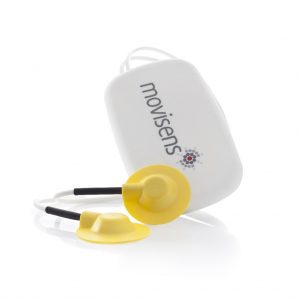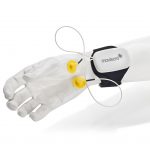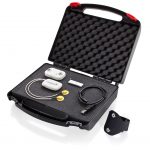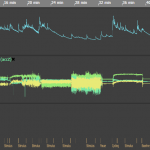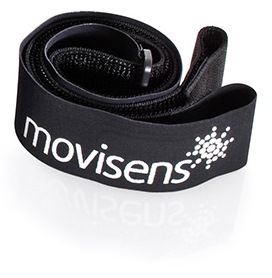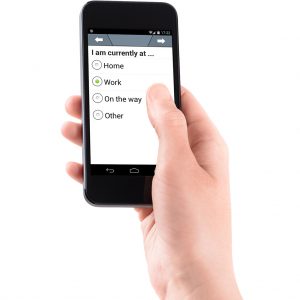edaMove – EDA- und Aktivitätssensor
Der movisens edaMove ist ein psychophysiologisches ambulantes Messsystem – optimiert für den Einsatz in der Forschung.
Der Sensor zeichnet die Rohdaten des EDA-Signals (elektrodermale Aktivität bzw. Hautleitwert), der 3-Achsen-Beschleunigung, des barometrischen Höhensensors und der Temperatur über bis zu 2 Wochen auf.
Aus diesen Messparametern können mit der Analyse-Software DataAnalyzer Ausgabeparameter wie Skin Conductance Level (SCL), Skin Conductance Responses (SCR) und Aktivitätsintensität berechnet (Excel) werden. Der Sensor wird mit einem Armand getragen. Der Sensor ist sowohl mit Mehrweg- als auch mit Einweg-Elektroden lieferbar.
Für kostenfreies Studentenprojekt bewerben
Top-Features
- Berücksichtigung von einschlägigen EDA-Standards
- Perfekte Signalqualität auch im Alltag
- Enthält Aktivitätssensor für Kontextinformationen
- Nachhaltige Daten durch offenes Rohdatenformat
- Praktikable und einfache Handhabung in Studien
- Offene Schnittstellen: SDK für Bluetooth und USB
Anwendungen
- Mobiles EDA-Langzeit-Monitoring
- Psycho-physiologisches Monitoring
- Untersuchung des vegetativen Nervensystems (autonomen Nervensystems ANS)
- Verhaltensmonitoring
- Wirtschaftspsychologie
- Klinische Psychologie
- Affective Computing
- Integration in komplexe Systeme
Dazu passende Produkte und Dienstleistungen
Downloads
| Software |
|
|---|---|
| Dokumentation |
|
| Beispieldaten |
|
| Externe Tools |
Technical data
| Power supply | Lithium-Ion battery |
| Supply voltage | 3 V |
| Accumulator voltage | 2.7 – 4.2 V |
| Number of charging cycles | 300 with 1C/1C > 80% |
| Maximum recording capacity | ~ 2 weeks, depending on manufacturer configuration |
| Battery run time (recording, Bluetooth off) | ~ 1,5 days |
| Size of sensor (W x H x D ) | 62.3mm x 38.6mm x 10.5mm |
| Weight of sensor | 26,2 g |
| Internal sensor | EDA-Amplifier: Exosomatic method, DC, 0.5V Resolution 14bit, Input range 2µS up to100µS Bandwith: DC to 8Hz Output rate: 32Hz
3D acceleration sensor: Measurement range: +/- 8 g Noise: 4 mg Output rate: 64 Hz
Pressure sensor: Measurement range: 300 - 1100 hPa Noise: 0.03 hPa Output rate: 1 Hz |
| Indicators | LED, 3-color (operation and charging status) Vibrating alert (start and end of measurement) |
| Interfaces | Micro-USB, Bluetooth |
| Environmental conditions | Temperature: -20 °C to 60 °C 0 °C to 45 °C during charging
Humidity: 0 to 75% RH relative humidity
Atmospheric pressure: 300 to 1100 hPa absolute |
Literatur
- A Comparison between Laboratory and Wearable Sensors in the Context of Physiological Synchrony.
- Moments That Matter? On the Complexity of Using Triggers Based on Skin Conductance to Sample Arousing Events Within an Experience Sampling Framework..
- Evaluating Usability Aspects of a Mixed Reality Solution for Immersive Analytics in Industry 4.0 Scenarios.
- Social anxiety is associated with heart rate but not gaze behavior in a real social interaction..
- Measuring Behavior 2020-21.
- Physiological synchrony in EEG, electrodermal activity and heart
rate reflects shared selective auditory attention. - Applicability of Immersive Analytics in Mixed Reality: Usability Study.
- Electrodermal activity patterns in sleep stages and their utility for sleep versus wake classification.
- A mixed-methods study of physiological reactivity to domain-specific problem solving: methodological perspectives for process-accompanying research in VET.
- Estudo piloto em câmara climática: efeito da luz natural em aspectos de saúde e bem-estar não relacionados à visão.
- Detecting cognitive underload in train driving: A physiological approach.
- Mobile Sensors for Multiparametric Monitoring in Epileptic Patients.
- A personalized and reconfigurable cyberphysical system to handle multi-parametric data acquisition and analysis for mobile monitoring of epileptic patients.
- Evaluation of environmental effects on the measurement of electrodermal activity under real-life conditions.
- Komfortgewinn für Passagiere auf Langstreckenflügen durch den Einsatz chronobiologisch angepasster LED-Kabinenbeleuchtung.
- Publication recommendations for electrodermal measurements.
